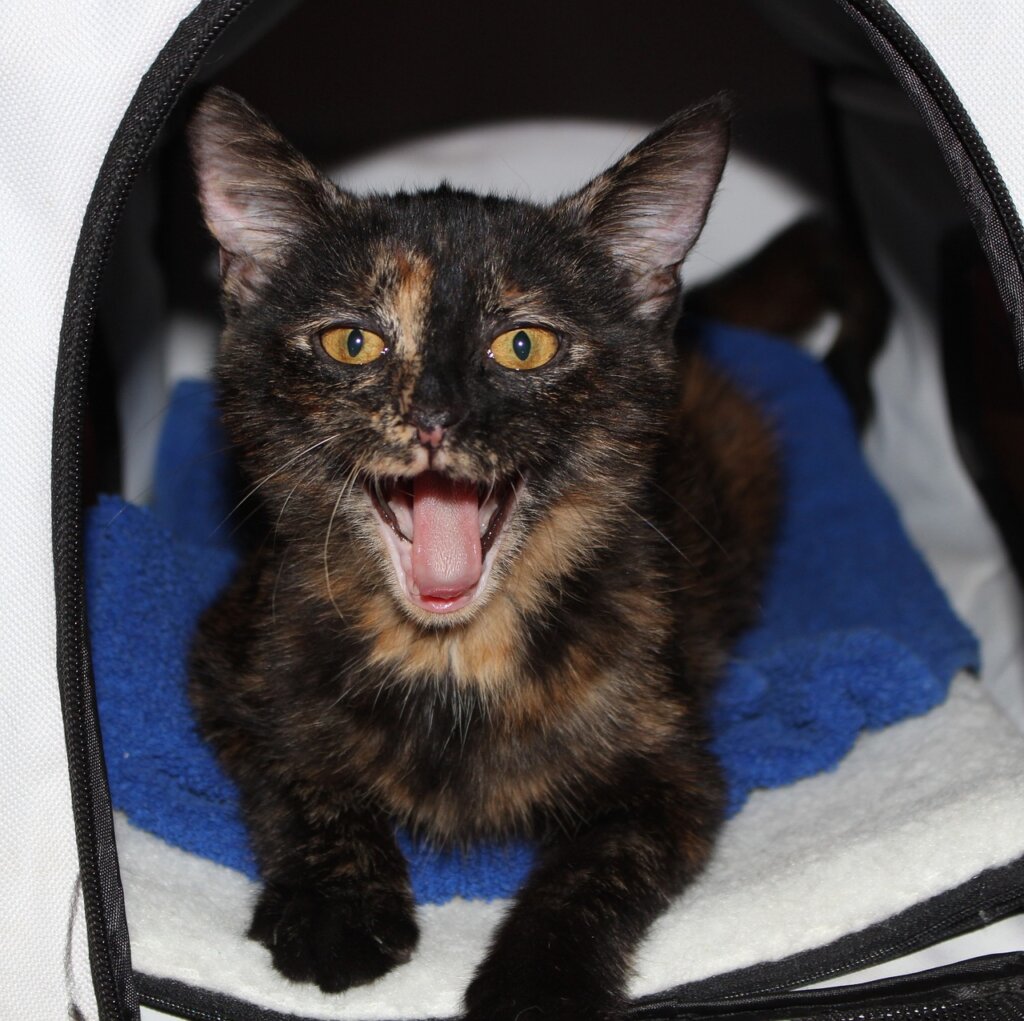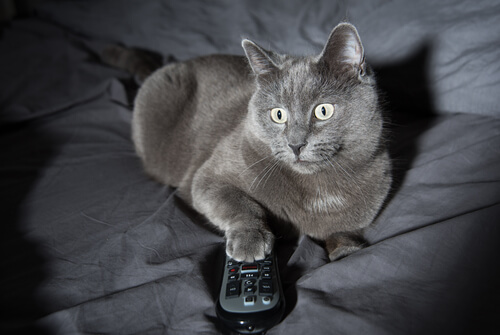9 Signs Your Cat Is the Boss at Home

Domestic cats are territorial animals that can be a bit inflexible in some situations. Although this behavior is normal because of their temperament, it isn’t always good to let them do whatever they want. In the worst case scenario, the cat will start to rule the roost in the house, which will create problems and conflicts with the family. Find out if your cat is the boss in your house!
It’s understandable that we should want to indulge some of our pet’s whims and pamper it a little. However, the pet shouldn’t be given the position of leader. Otherwise, instead of being friendly or peaceful, they’ll become more sullen, overprotective, and aggressive. Continue reading this space and discover some of the signs that could show that your cat is the boss in your house.
Is it good for the cat to be the boss in your house?
When you have a pet cat, there must be a hierarchy in the home with the owner as the leader. This means that cats will perceive humans as authority figures and respect them. Thanks to this, they’ll attend to instructions and commands better and will be less stubborn about their attitudes.
The fact that a person acts as a leader doesn’t prevent them from playing or having fun with their pets. On the contrary, they’re able to interact in the best way and provide for their needs. Likewise, they’ll set limits and reprimand appropriately if mistakes are made. This allows you to improve the coexistence in the home and to maintain a healthy relationship with the animals.
On the other hand, when the cat is the boss at home (the dominant one), a rigid environment is created in which the cat decides the rules and demands the fulfillment of its whims. Of course, if these rules are broken, aggressive behaviors such as scratching, biting, or destroying objects can appear. This is the main reason why owners often give in and let the cat control the home.
It’s important to emphasize that letting the cat be the leader not only causes conflicts in the home, but also generates constant stress. In the end, the cat is focused on protecting its environment, and it must be alert to any eventuality. It isn’t hard to imagine that this pressure causes long-term health problems and leads to conflict in the home.

Signs that your cat is the boss at home
There are several signs that indicate that your cat is the boss, or the dominant one, in your home. However, some are a bit more subtle and aren’t always taken as such. Among the most frequent are the following.
1. They don’t allow strangers (animals or humans) to enter the house
Perhaps one of the most obvious signs that your cat is in control is that they don’t allow any strangers to enter. In addition, when they “dare” to enter, they’ll attack them, meow incessantly or hiss at them. Such behavior doesn’t stop unless the guest leaves, which creates a lot of awkwardness for the family.
This behavior shouldn’t be confused with normal pet discomfort or aversion. If your cat doesn’t like visitors, but does nothing to “see them off” or make them feel uncomfortable, it means that they know their limits and don’t want to impose themselves on the situation. So, don’t scold them, give them their space and help them feel safe.
2. They don’t accept changes in the home
People are used to changing or reconditioning their homes relatively frequently, according to their needs at any given moment. However, cats have a natural aversion to change and modification of their routine. For this reason, it’s common for them to hate moving, changing furniture, and altering their environment.
As with the previous point, it’s normal for cats to become stressed or show certain aggressive behavior when faced with these changes. However, if the negative behavior doesn’t stop and you have to resort to putting things back as they were before in order to calm the situation down, then there’s a problem with the cat’s position in the home.
3. They do their business anywhere
This is one of the most conflicting signs that your cat is the boss at home. Usually, felines choose comfortable, private, and quiet places to relieve themselves. That’s why it’s recommended to put their litter box in a fresh and well-ventilated place away from noise.
The fact that a cat doesn’t want to do its needs in a litter box doesn’t necessarily mean it wants to impose its will; it may be uncomfortable with the place. If, despite changing its litter box several times, the cat continues to refuse to obey orders, then it’s likely to have a behavioral problem.
It’s understandable that, in this case, the line dividing what is “normal” and what is “bad” isn’t entirely clear. But keep in mind that, if your cat is dominant and in charge in your home, there will be more signs to show you that there’s a problem.
4. They interfere with your daily activities
Cats decide when they want their owner’s attention or need some time alone. It’s easy to distinguish between the two because they exhibit polarized behaviors. Looked at another way, they’re very aggressive in their moments of isolation and are overly affectionate in their affectionate moments.
Although this behavior is normal in domestic cats, it shouldn’t be allowed to interfere with the owner’s daily activities. The moment a person has to stop working, eating, or sleeping because their cat asks for affection, then they’re giving the cat consent to impose its will.
Of course, neither is it right to impose yourself on the cat and stroke them when they aren’t receptive. The point is to find a balance and arrange a time when the owner and cat can play, interact and enjoy their time together. Of course, this isn’t always straightforward, but it’s the best way to avoid conflicts in daily life.

5. The owner fits into the cat’s routine
Cats have a twilight activity pattern. This means that their peak energy tends to occur at dusk, so it’s common to see them a little more active at this time of day. On the contrary, humans have a diurnal life and their energy decreases as it gets darker, which could create problems in coexistence.
In most cases, owners seek to get their cat to fit into the their rhythm of life, which isn’t always wrong, as long as the pet allows it. However, some families go out of their way or sacrifice their sleep in order to satisfy their cat. Needless to say, this is wrong and should be corrected as soon as possible.
6. Aggression when their requests aren’t met
Cats use their meowing as a tool to communicate and make requests to their owners. Although this is normal, certain restrictions should be placed on which requests can and can’t be granted. If your cat stop their behavior when you refuse to bend to their request, then there’s nothing to worry about. However, if they start to become aggressive and want to assert themselves, then there is a problem.
7. They don’t respect household objects
Destructive behavior can be caused by unhappiness regarding some aspect of their environment, a need to mark their territory, or a lack of attention. Although such behavior doesn’t always represent a dominance problem, it is possible to take it as a warning sign.
When the pet wants to impose its will, it demonstrates it with destructive behavior to attract their owner’s attention. By destroying objects, they are sending an urgent request that must be attended to as soon as possible. If you don’t cede to their needs, they may break, scratch, or destroy other things until they get what they want.
8. Excessive emotional bond
The emotional bond between the cat and its owner can become so important that the pet begins to consider you as “its property.” This in itself isn’t harmful, as it’s one of the many ways felines show their affection and appreciation.
The problem arises when the cat doesn’t allow any stranger (animal or person) to approach its owner. If they do, it exhibits exaggerated aggressive behavior that could even hurt the owner. As you might expect, the feline tries to defend its “property” and impose its will to ensure that no one should approach it, which affects coexistence with other people.
9. Invading or taking possession of the family’s belongings
Cats are curious by nature, so it’s common to observe them snooping in their family’s belongings. Although this is considered normal, dominant felines tend to invade and take possession of these belongings. They even exhibit aggressive behavior if an attempt is made to retrieve them.
What do I do if my cat wants to rule my home?
Contrary to popular belief, it isn’t advisable to let a cat impose its will in the home, as this makes it more prone to develop behavioral problems. According to a study published in the scientific journal Applied Animal Behaviour Science, cat owners report more positive attitudes and experiences when there’s a reciprocal relationship between owner-dominant and cat-submissive.
If the cat already exhibits dominant behavior, there are two ways to address them. The first is through a change in the owner’s behavior, which consists of taking on the role of leader. While the second consists of the support of behavioral therapies or drugs to soften the feline’s temperament. Both options need to be carried out with the help of a veterinarian and an ethologist.

A leader doesn’t impose their will
The concept of a leader tends to be very distorted by the experiences that the owners have in their lives. However, a good leader doesn’t impose his or her will, but rather opts for the intermediate points that benefit the family the most. In other words, don’t expect your cat to do everything you tell them to do and comply with all your rules.
Apart from the fact that this is impossible, with these expectations you’ll only stress your pet and yourself. The goal is to guide your cat to understand the limits and improve coexistence. And why not also offer some treats to deepen your relationship from time to time?
As you can see, these signs that the cat is the boss at home should be taken seriously and very carefully. Although they seem innocent and sometimes rather sweet, they could cause long-term cohabitation problems if they aren’t resolved in time. So, if you detect any of them, go to a professional to help correct them in the most appropriate way.
All cited sources were thoroughly reviewed by our team to ensure their quality, reliability, currency, and validity. The bibliography of this article was considered reliable and of academic or scientific accuracy.
- Crowell-Davis, S. L., Curtis, T. M., & Knowles, R. J. (2004). Social organization in the cat: a modern understanding. Journal of feline medicine and surgery, 6(1), 19-28. https://journals.sagepub.com/doi/pdf/10.1016/j.jfms.2003.09.013
- Bernstein, P. L., & Strack, M. (1996). A game of cat and house: spatial patterns and behavior of 14 domestic cats (Felis catus) in the home. Anthrozoös, 9(1), 25-39. https://www.tandfonline.com/doi/abs/10.2752/089279396787001572
- McKeown, D., Luescher, A., & Machum, M. (1988). The problem of destructive scratching by cats. The Canadian Veterinary Journal, 29(12), 1017. https://www.ncbi.nlm.nih.gov/pmc/articles/PMC1681050/pdf/canvetj00577-0063.pdf
- Zeigler-Hill, V., & Highfill, L. (2010). Applying the interpersonal circumplex to the behavioral styles of dogs and cats. Applied Animal Behaviour Science, 124(3-4), 104-112. https://www.sciencedirect.com/science/article/abs/pii/S0168159110000766
- Litchfield, C. A., Quinton, G., Tindle, H., Chiera, B., Kikillus, K. H., & Roetman, P. (2017). The ‘Feline Five’: An exploration of personality in pet cats (Felis catus). PLoS One, 12(8), e0183455. https://journals.plos.org/plosone/article?id=10.1371/journal.pone.0183455
- Overall, K. L., Rodan, I., Beaver, B. V., Carney, H., Crowell-Davis, S., Hird, N., … & Wexler-Mitchel, E. (2005). Feline behavior guidelines from the American Association of Feline Practitioners. Journal of the American Veterinary Medical Association, 227(1), 70-84. https://europepmc.org/article/med/16013540
- Askew, H. R. (1996). Treatment of behavior problems in dogs and cats: a guide for the small animal veterinarian. Blackwell Science Ltd. https://www.cabdirect.org/cabdirect/abstract/19972204283
This text is provided for informational purposes only and does not replace consultation with a professional. If in doubt, consult your specialist.